
Concept explainers
(a)
The value of
Answer to Problem 74QAP
The value of
Explanation of Solution
Given data:
Formula Used:
Newton's second law:
Calculation:
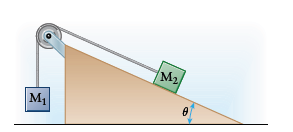
We'll use two different but related coordinate systems for the two blocks. For block
We can draw free-body diagrams and apply Newton's second law in component form for both blocks.
The tension acting on each block will be identical in magnitude.
Since block
Since, both blocks are at rest, which means the acceleration of each block is zero and we can calculate
.
Free-body diagram of
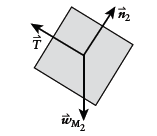
Newton's second law for
Free-body diagram of
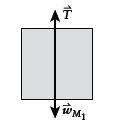
Conclusion:
For two blocks to be in equilibrium the value of
(b)
The magnitude of acceleration of two blocks if the system can move.
Answer to Problem 74QAP
The magnitude of acceleration of two blocks
Explanation of Solution
Given data:
Formula Used:
Newton's second law:
Calculation:
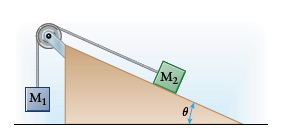
We'll use two different but related coordinate systems for the two blocks. For block
We can draw free-body diagrams and apply Newton's second law in component form for both blocks.
The tension acting on each block will be identical in magnitude.
Since block
Since,
The magnitude of the acceleration will be the same for each block because they are joined together with a string.
Free-body diagram of
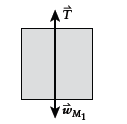
Free-body diagram of
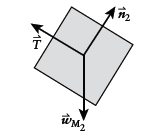
Newton's second law for
Conclusion:
If the system can move the magnitude of acceleration of two blocks is
(c)
The direction of
Answer to Problem 74QAP
The direction of
Explanation of Solution
Given data:
Formula Used:
Newton's second law:
Calculation:
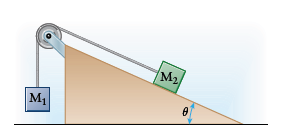
We'll use two different but related coordinate systems for the two blocks. For block
We can draw free-body diagrams and apply Newton's second law in component form for both blocks.
The tension acting on each block will be identical in magnitude.
Since block
Since,
Free-body diagram of
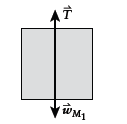
Free-body diagram of
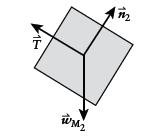
Newton's second law for
Since
Conclusion:
As we have value of
(d)
The distance to which block
Answer to Problem 74QAP
The distance to which block
Explanation of Solution
Given data:
Formula Used:
Newton's second law:
And
Calculation:

We'll use two different but related coordinate systems for the two blocks. For block
We can draw free-body diagrams and apply Newton's second law in component form for both blocks.
The tension acting on each block will be identical in magnitude.
Since block
Since,
If the acceleration is constant, we can use the constant acceleration equations to calculate how far
Free-body diagram of
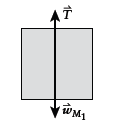
Free-body diagram of
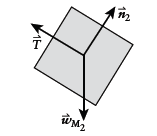
Newton's second law for
By using the constant acceleration equations to calculate how far
Conclusion:
Thus in
Want to see more full solutions like this?
Chapter 4 Solutions
COLLEGE PHYSICS-ACHIEVE AC (1-TERM)
- How long will it take you to double your money if you invest it at a rate of 8% compounded annually?arrow_forwardOne hundred dollars is invested at 7.2% interest compounded annually. Determine how much the investment is worth after: a. I year b. 5 years c. 10 years d. 20 years e. Use your answers to parts (a)-(d) to estimate the doubling time for the investment.arrow_forward6) A farmer has 60 acres on which to plant oats or corn. Each acre of oats requires 100 lbs of fertilizer and 1 hour of labor. Each acre of corn requires 50 lbs of fertilizer and 2 hours of labor. The farmer has 5000 lbs of fertilizer and 100 hours available for labor. If the profit is $60 from each acre of oats and $100 from each acre of corn, what planting combination will produce the greatest total profit? a) Fill in the following chart to help organize the information given in the problem: Oats Labor Fertilizer Land Profit b) Write down the question of interest. Corn Available c) Define variables to answer the question of interest. Call these x and y. d) Write the objective function to answer the question of interest. e) List any constraints given in the problem.arrow_forward
- I need help with number 5.arrow_forward3) Use the following system of linear inequalities graphed below to answer the questions. a) Use the graph to write the symbolic form of the system of linear inequalities. b) Is (-4,2) a solution to the system? Explain. 5 -7 -5 -3 -2 0 2 3 4 $ 6 -2 -6 -7arrow_forward) Graph the feasible region subject to the following constraints. x + y ≤ 6 y ≤ 2x x ≥ 0, y ≥ 0 P + xarrow_forward
- Solve the following system of equations: 50x+20y=1800 10x+3y=300arrow_forward> > > we are hiring Salesforce Admin Location: Remote Key Responsibilities: Administer Salesforce Sales & Revenue Cloud (CPQ & Billing) Configure workflows, validation rules & dashboards Automate processes using Flows & Process Builder Collaborate with Sales, Finance & Marketing teams Manage user roles & security Apply: Hr@forcecraver.comarrow_forwardAnswer this questionarrow_forward
- 1. vector projection. Assume, ER1001 and you know the following: ||||=4, 7=-0.5.7. For each of the following, explicitly compute the value. འབ (a) (b) (c) (d) answer. Explicitly compute ||y7||. Explain your answer. Explicitly compute the cosine similarity of and y. Explain your Explicitly compute (x, y). Explain your answer. Find the projection of onto y and the projection of onto .arrow_forward2. Answer the following questions using vectors u and v. --0-0-0 = find the the cosine similarity and the angle between u and v. འརྒྱ (a) (b) find the scalar projection of u onto v. (c) find the projection of u onto v. (d) (e) (f) find the scalar projection of onto u. find the projection of u onto u. find the projection of u onto and the projection of onto . (Hint: find the inner product and verify the orthogonality)arrow_forwardPlease type out answerarrow_forward
 Trigonometry (MindTap Course List)TrigonometryISBN:9781305652224Author:Charles P. McKeague, Mark D. TurnerPublisher:Cengage LearningAlgebra & Trigonometry with Analytic GeometryAlgebraISBN:9781133382119Author:SwokowskiPublisher:Cengage
Trigonometry (MindTap Course List)TrigonometryISBN:9781305652224Author:Charles P. McKeague, Mark D. TurnerPublisher:Cengage LearningAlgebra & Trigonometry with Analytic GeometryAlgebraISBN:9781133382119Author:SwokowskiPublisher:Cengage Algebra and Trigonometry (MindTap Course List)AlgebraISBN:9781305071742Author:James Stewart, Lothar Redlin, Saleem WatsonPublisher:Cengage Learning
Algebra and Trigonometry (MindTap Course List)AlgebraISBN:9781305071742Author:James Stewart, Lothar Redlin, Saleem WatsonPublisher:Cengage Learning Linear Algebra: A Modern IntroductionAlgebraISBN:9781285463247Author:David PoolePublisher:Cengage Learning
Linear Algebra: A Modern IntroductionAlgebraISBN:9781285463247Author:David PoolePublisher:Cengage Learning



